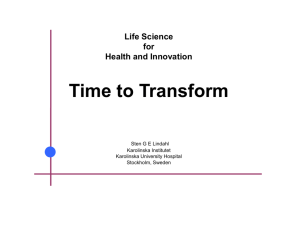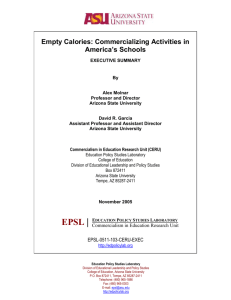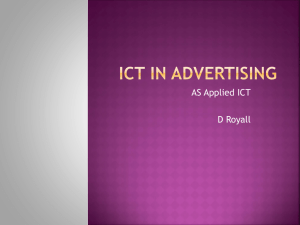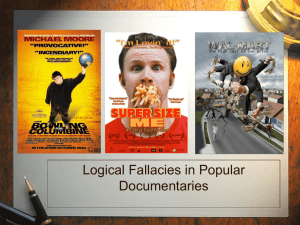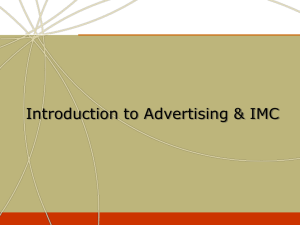Commercialism
advertisement
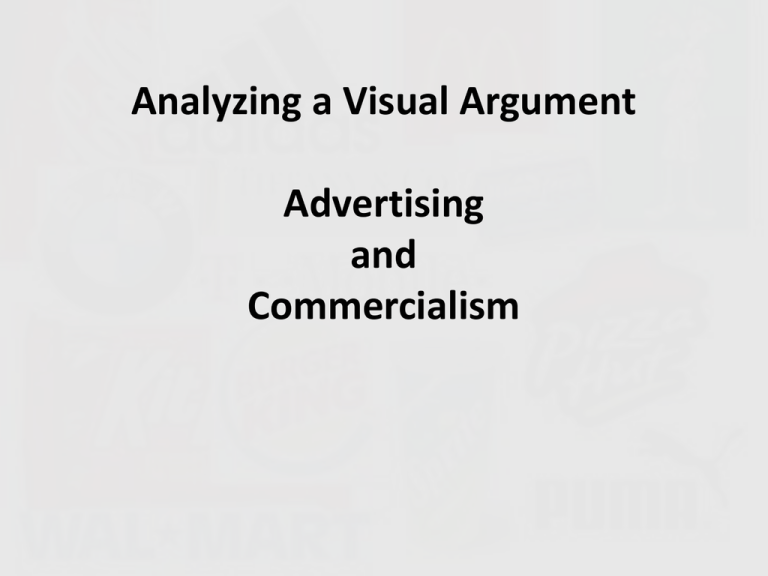
Analyzing a Visual Argument Advertising and Commercialism Analyzing a Visual Argument Are you a BELIEVER or a DOUBTER? Do you tend to believe and trust what people say or are you a skeptic who doubts and questions everything? Try to be BOTH as you view these video clips. • Watch each of the following video clips about Commercialism, and respond to each one in your Writer’s Notebook with the following statements: • I BELIEVE that . . . • I DOUBT that . . . Commercialism Personal Space and Freedom • Marketers compile detailed electronic portraits of shoppers. Companies sell mailing lists for everything from foreign car ownership to sexual preference. These computer databases present a staggering potential for abuse. • Commercialism has spread into almost every aspect of life. Being unable to escape, it is annoying to many. • Ads take a lot of our time. The average person spends almost an hour a day reading, watching, or listening to ads through TV, radio, theaters, videotapes, newspapers, magazines, mail, or telephone. By the time the average American is seventy-five years old, advertising will have taken four years of his or her life. The Merchants of Cool Frontline Program http://www.youtube.com/watch?v=gdzxc8Fpn3o Commercialism Personal Fulfillment • Advertising implies that there's an easy solution to everything, from being healthy to having friends. • Many ads imply, even if they don't say outright, that happiness is something we can buy. When we act as though this is true, our personal horizons and ability to find fulfillment in life are limited. • Advertising fosters dissatisfaction, envy, and insecurity. It can make us feel unattractive, uncool, and unhappy with what we do or don't have. • Our commercialized society places a strong emphasis on appearance, encouraging us to care about our own and others' appearances rather than about character, talent, and personality. • Advertising often causes people, especially young girls, to have a negative body image. http://www.youtube.com/watch?v=DnJQJFlyDGY Commercialism Cultural and Artistic Impact • Paid product placements influence the content of music, movies, TV shows, and books. This compromises artistic integrity. • Commercialism distorts our culture by turning every event into a reason to consume. • Anthropologists say that holidays reflect a culture's values. In America, every holiday is a sales event. The Merchants of Cool Frontline Program MTV: The Power of Marketing http://www.youtube.com/watch?v=GQBwaz_zzHA (start at 6:00) http://www.youtube.com/watch?v=-j2tASIAfF8 Commercialism Social and Economic Impact • Advertising projects false images and perpetuates stereotypes. • Constant exposure to ads may encourage materialism and selfishness. This may make people less inclined to help others. • Commercialism does not just promote specific products. It promotes consumption as a way of life. • Our commercialized culture encourages people to spend money that they don't really have. The number of Americans with financial problems has increased steadily in recent years. • Advertising costs us money. Businesses pass many of their advertising costs on to us. Super Size Me http://www.youtube.com/watch?v=P6wJdsYM7qA&feature=related http://www.youtube.com/watch?v=R2LBwyhtuTo&feature=related Commercialism Health Impact •Commercial foods and the ads for them tend to encourage unhealthy eating habits. Super Size Me http://www.youtube.com/watch?v=4N5i-0t8m94&feature=fvwrel http://www.youtube.com/watch?v=4wmac-INoXg Commercialism Environmental Impact •Commercialism contributes to environmental problems by encouraging wasteful use of natural resources. •Over-packaging, disposable goods, and buying things we don't really need all contribute to unnecessary use of limited resources. •Billboards cause visual pollution. Urban Sign Pollution http://www.youtube.com/watch?v=WTEK9yr8zR4 Commercialism: Self-Mocking Ads Just for Fun! Advertisers mock their own advertising strategies in a humorous way, but the purpose is the same: to sell their product or message! http://www.youtube.com/watch?v=jBjBFSBLdp0&feature=related http://2012.talkingpointsmemo.com/2011/12/rick-perrys-desperate-measures.php http://www.youtube.com/watch?v=pPIzLPx6T-U Read the essay together: “Do You Want Lies With That?” From Don’t Eat this Book By Morgan Spurlock. •The book was written in 2005 after his documentary Super Size Me had become well-known. •Think about what might have motivated him to write the book and who his audience was. •In your WNB, after each section that I read, write the following: Summary statement I believe that . . . I doubt that . . . The Rhetorical Triangle Context/Occasion: Americans have become more unhealthy as advertising has encouraged more consumption. Spurlock wrote the book after the movie Super Size Me to build his argument more. Title of Essay: “Do You Want Lies with That” by Morgan Spurlock Subject/Text: Overconsumption is a problem in America, and the article focuses particularly on the auto, food, and drug industries. Logos: (FACTS) 5 million people died from smoking in 2000; in 1971, cigarette ads were banned from TV; in 2003, auto industry spent $18.2 billion on advertising; in 2003 Americans spent $227 billion on medications; many products are made to look like food to sell them (rings, cigarettes, toys) Purpose: Author/Speaker: Morgan Spurlock—the director of documentaries like Super Size Me; liberal critic of society; uses humor, sarcasm, and entertainment to inform the public about problems. To convince the audience that Americans are being manipulated by advertisers to over-consume Claim: Americans are over-consuming, and the problem starts with the food industry and with the deceptive practices of advertising. Ethos: He does not refer to his own reputation, but he does use the reference to the Surgeon General to build his credibility about the dangers of smoking. Fallacies: Slippery slope: “Americans are eating themselves to death” Hasty Generalization: “Everyone smoked.” False Analogy: “This is the power of advertising at work, of billions of hooks that’ve been cast into our heads . . .” (Compares us to fish) Audience: People who are over-consuming in society and are unaware of the deceptive practices of advertisers Pathos: “But your desires. . . Tone: that’s all manipulated by corporate advertising and marketing . . .” (Appeals to your emotion of fear that you are being manipulated) Write a paragraph analyzing the article “Do You Want Lies with That?” by Morgan Spurlock. Use all of your analysis from your rhetorical triangle to help you with the paragraph. Be sure to include the following: •Introductory sentence that identifies the title, author, and the claim of the essay •Explain the components of the rhetorical triangle. Be sure to address the three components (author, audience, and subject) and the three appeals (logos, pathos, and ethos). •Analyze and explain any fallacies that you find. •Concluding sentence that explains whether you think this essay makes a just or unjust claim. Student Sample Paragraph In the essay “Do You Want Lies with That?” from his book Do Not Eat This Book, Morgan Spurlock persuades the audience to wake up and admit the problems that over-consumption causes in society. Spurlock uses logos to show us the power of big tobacco companies. For example, he states that tobacco companies agreed to settlements of $246 billion. He also focuses on how influential advertisers are and how much money they spend to persuade us to buy products. “In 2003, the auto industry spent $18.2 billion telling us we needed a new car, more cars, bigger cars.” Spurlock also uses pathos by appealing to our basic human rights and desires, “We are responsible for our own life, our rights, and our desires, but we are being influenced by big name corporations.” This makes the audience feel manipulated to persuade them to do something about it. Spurlock builds his ethos by referring to the Surgeon General’s warning about smoking, which supports his own statement about the dangers of smoking. Although Spurlock is guilty of the fallacies of slippery slope and hasty generalizations, and his comparison of consumers to fish is a faulty analogy, his claim is still powerful due to his strong use of logos. His facts about the influence of advertising and the dangers of overconsumption in our society are very convincing.


